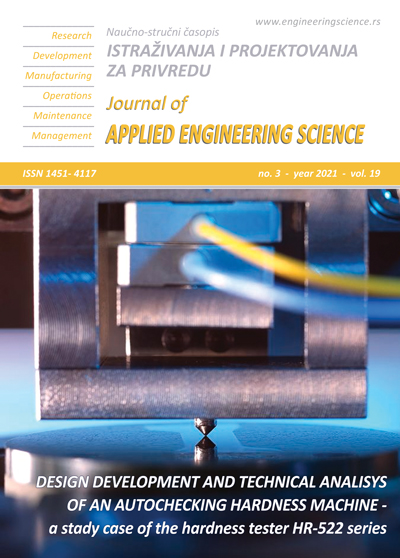APPLICATION OF QUALITY PLANNING TO OPTIMIZE PRODUCT AND CONSTRUCTION PROJECT QUALITY
Abstract
A country is called developed when the capacity and progress of science and technology have created products that always meet the requirements and increasing needs of people, ensuring stability and development of the nation in particular and the movement of the world in general. In Vietnam, the quality of goods is still modest. This exists not only from a macro perspective but also from a micro perspective and the transition from macro to micro because of a lack of orientation, or can be called the lack of "Product quality planning” [21,25] in terms of space. This paper will discuss the concepts of quality, expand the concept of quality with the aim of achieving good quality, meeting increasing requirements, need to perform the "quality planning" work under the space degree. The paper uses a mathematical tool based on the Cartesian coordinate system to determine the optimal value of product quality in order to demonstrate quantitatively according to the spatial frameworks when the quality is desired to achieve the required perfection through the magnitude of the "quality demand.” In a similar way, in order to get the construction project achieve the maximum quality, there must be adjustment solutions in 3 aspects. However, at present, in Vietnam in particular and the world in general, there have not been many in-depth studies on the formation of quality and the factors affecting the quality, especially the industrial construction projects [3]. Through the success or failure of investment projects in the form of public private partnerships (PPP) of countries around the world, including developed countries, the author thinks that in order for the project to be successful, it is necessary to apply construction product quality planning.
References
[2] Thai Ba Can (2003). Financial management in the field of construction investment, Finance Publisher.
[3] Nguyen Quoc Cu (2000). Quality control of products according to TQM and ISO - 9000, Science and Technology Publishing House.
[4] Nguyen Ngoc Chau (2000). Urban Management, Construction Publishing House.
[5] Dinh Si Chuong (1999). ISO - 9000 - Explanation and guidance for application in construction, construction publishing houses.
[6] Government of Vietnam (2008). ND69/2008/ND-CP, socialization of education and training.
[7] Government of Vietnam (2015). ND46/2015/ND-CP, Quality management and maintenance of construction works.
[8] Nguyen Van Dang (2020). Project Manager, Construction Publishing House.
[9] Constantine Michael Koursaris, William Clifford Manley (2018). A Process Control Model for Effectively Managing Product Quality Variation in a Global Production Manufacturing Setting, The Global Studies Journal.
[10] Bui Nguyen Hung (1992). Comprehensive Quality Management, Young Publishing House.
[11] Idris Othman; Siti Norfarahhanim Mohd Ghani; Shim Woon Choon (2019). The Total Quality Management (TQM) journey of Malaysian building contractors, Ain Shams Engineering Journal.
[12] Kaosn Ishikawa (1994). Quality management by Japanese method, Statistical Publishing House.
[13] Nataly Gritsenko, Elizaveta Rud (2019). Development Of An Effective Product Quality Management System, Technology audit and production reserves journal.
[14] Mohammad Yogie Latansa, Tri Joko Wahyu Adi, Mohammad Arif Rohman (2019). Analysis The Effect of Total Quality Management, Technology, and Knowledge Management on Product Quality in Indonesia Construction Industry, IPTEK Journal of Proceedings.
[15] M. Söderlund (1998). Customer satisfaction and its consequences on customer behavior revisited: The impact of different levels of satisfaction on word-of-mouth, feedback to the supplier, International Journal of Service Industry Management, vol. 9, no. 2, pp. 169-188.
[16] Okalan 3S (1994). Uniform quality management, Statistical Publishing House.
[17] Pristavka, M., Bujna. M. (2014). Monitoring the capability of production equipment in organization, in Acta Technologica Agriculturae, vol. 17, no.2, Nitra: Slovaca Universitas Agriculturae Nitriae, pp. 39-43.
[18] S. Elonen, K. A. (2003). Artto. Problems in managing internal development projects in multi-project environments. International Journal of Project Management, Vol. 21, No. 6, pp. 395-402.
[19] S. Christensen, K. Kreiner (1997). Projektledning: att Leda och lära i en ofullkomlig värld.
[20] Nguyen Truong Son (2003). Basic issues on quality management, Statistical Publishing House.
[21] Luu Thanh Tam (2003). Quality management according to international standards, Ho Chi Minh City National Publishing House.
[22] Nguyen Quang Toan (1999). ISO - 9000 and TQM set up a quality-oriented management system, Statistical Publishing House.
[23] Hoang Manh Tuan (1997). Innovating product quality management in the new period, Hanoi Science and Technology Publishing House.
[24] Truong Quang Thao (2001). Introduction to Urban Studies - Construction Publishing House.
[25] Le Manh Tuong (2014). Product quality planning, Transport science and technology journal.
[26] Wayne R. Mondy, Shane R. Premeaux (1997). Management, Prentice Hall Intl. 7th edition.
[27] Zashorska, R., Nozdrovický, L., Mikulásik, L’. (2016). Implementation of statistical methods and swot analysis for evaluation of metal waste management in engineering company, in Acta Technologica Agriculturae, vol. 19, no.4, Nitra: Slovaca Universitas Agriculturae Nitriae, pp. 89-95.
[28] Zheng-Yong Zhang et al. (2019). Raman chemical feature extraction for quality control of dairy products, Journal of Dairy Science.

